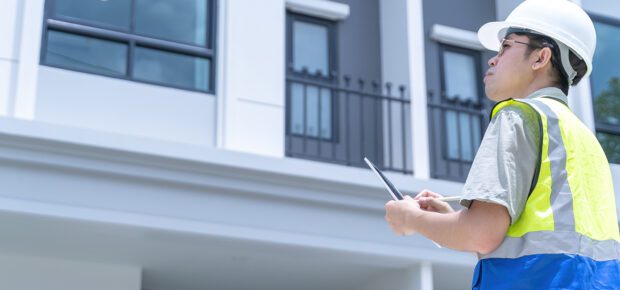May 9, 2024
From talking thermostats to garage doors that greet you on arrival, the smart home seems like a modern marvel. But are these high-tech habitats really as “smart” as they claim, or just cleverly disguised remote controls for our comfort and convenience?
Smart homes incorporate a variety of sensors and devices that enable automation in several ways. Smartphone apps can control appliances, garage doors and sound systems. Lights can be controlled by voice commands. Thermostats can use artificial intelligence to determine a combination of energy usage and comfort.
However, sensors that can monitor the house’s health are often overlooked.
Structural health monitoring (SHM) sensors take things a step further, transforming smart homes into smarter homes. These sensors, alongside artificial intelligence, can monitor the structural health of the house, along with various systems such as heating and ventilation, electrical and plumbing.
SHM systems, already used to protect infrastructure like bridges, dams and pipelines, are advanced technologies designed to monitor and assess the health of structures in real-time. These systems comprise a range of sensors, instrumentation devices and automatic data acquisition systems. They continuously monitor load, vibrations, displacement, strain, moisture and other factors using piezoelectric, accelerometers, ultrasound, strain gauges and fiber optics. This real-time data provides valuable insights into structural integrity to identify and address potential issues before they escalate.
How sensors can make homes smart homes smarter
SHM systems combined with artificial intelligence can identify potential issues in “smarter homes” before they escalate into major problems, including:
Foundation problems: SHM systems can monitor the stability of the foundation and identify any developing cracks, allowing for fast repairs before the structural integrity is compromised.
Wall and ceiling issues: These systems can detect cracks in walls and ceilings, potentially indicating foundation issues, settling or shrinkage. Early intervention can prevent them from growing and compromising the structural integrity.
Roof problems: SHM sensors can monitor vibrations and displacement, potentially revealing issues like sagging or loose roof tiles before they escalate and lead to collapse.
Water damage: Moisture sensors can detect hidden leaks or excessive moisture buildup, preventing water damage and potential mold growth, which can compromise structural integrity and pose health risks.
The way forward for “smarter homes”
SHM systems can detect problems early to enable:
Proactive maintenance: Addressing minor issues before they become major repairs saves homeowners money in the long run.
Enhanced safety: Early detection of potential structural failures ensures a safer living environment for homeowners and their families.
Financial issues: Continuous monitoring can help in lowering insurance costs, keeping the maintenance cost low, and providing time to schedule repairs before systemic collapse.
SHM systems can be tailored for making their way into smart homes considering their integration with smart home networks, wireless connectivity, simplified installation, user-friendly interfaces, customizable monitoring parameters, cost-effectiveness and scalability with security and privacy measures.
Optimizing SHM systems in smart homes can proactively ensure structural safety and longevity by preventing costly repairs. SHM systems can act as guardians of a smart home’s health.
About Our Authors
Nikhil Gupta is an IEEE Senior Member whose research focuses on cybersecurity in manufacturing, additive manufacturing, and structural health monitoring. Priyanka Nama is an IEEE Member whose research focuses on cybersecurity in sensors and the Internet of Things.






 Liquid Infrastructure: Our Planet's Most Precious Resource
Liquid Infrastructure: Our Planet's Most Precious Resource The Impact of Technology in 2025
The Impact of Technology in 2025 Quantum and AI: Safeguards or Threats to Cybersecurity?
Quantum and AI: Safeguards or Threats to Cybersecurity? Why AI Can't Live Without Us
Why AI Can't Live Without Us Bits, Bytes, Buildings and Bridges: Digital-Driven Infrastructure
Bits, Bytes, Buildings and Bridges: Digital-Driven Infrastructure Impact of Technology in 2024
Impact of Technology in 2024 Emerging AI Cybersecurity Challenges and Solutions
Emerging AI Cybersecurity Challenges and Solutions The Skies are Unlimited
The Skies are Unlimited Smart Cities 2030: How Tech is Reshaping Urbanscapes
Smart Cities 2030: How Tech is Reshaping Urbanscapes Impact of Technology 2023
Impact of Technology 2023 Cybersecurity for Life-Changing Innovations
Cybersecurity for Life-Changing Innovations Smarter Wearables Healthier Life
Smarter Wearables Healthier Life Infrastructure In Motion
Infrastructure In Motion The Impact of Tech in 2022 and Beyond
The Impact of Tech in 2022 and Beyond Cybersecurity, Technology and Protecting Our World
Cybersecurity, Technology and Protecting Our World How Technology Helps us Understand Our Health and Wellness
How Technology Helps us Understand Our Health and Wellness The Resilience of Humanity
The Resilience of Humanity Harnessing and Sustaining our Natural Resources
Harnessing and Sustaining our Natural Resources Creating Healthy Spaces Through Technology
Creating Healthy Spaces Through Technology Exceptional Infrastructure Challenges, Technology and Humanity
Exceptional Infrastructure Challenges, Technology and Humanity The Global Impact of IEEE's 802 Standards
The Global Impact of IEEE's 802 Standards Scenes of our Cyber Lives: The Security Threats and Technology Solutions Protecting Us
Scenes of our Cyber Lives: The Security Threats and Technology Solutions Protecting Us How Millennial Parents are Embracing Health and Wellness Technologies for Their Generation Alpha Kids
How Millennial Parents are Embracing Health and Wellness Technologies for Their Generation Alpha Kids Space Exploration, Technology and Our Lives
Space Exploration, Technology and Our Lives Global Innovation and the Environment
Global Innovation and the Environment How Technology, Privacy and Security are Changing Each Other (And Us)
How Technology, Privacy and Security are Changing Each Other (And Us) Find us in booth 31506, LVCC South Hall 3 and experience the Technology Moon Walk
Find us in booth 31506, LVCC South Hall 3 and experience the Technology Moon Walk Virtual and Mixed Reality
Virtual and Mixed Reality How Robots are Improving our Health
How Robots are Improving our Health IEEE Experts and the Robots They are Teaching
IEEE Experts and the Robots They are Teaching See how millennial parents around the world see AI impacting the lives of their tech-infused offspring
See how millennial parents around the world see AI impacting the lives of their tech-infused offspring Take the journey from farm to table and learn how IoT will help us reach the rising demand for food production
Take the journey from farm to table and learn how IoT will help us reach the rising demand for food production Watch technical experts discuss the latest cyber threats
Watch technical experts discuss the latest cyber threats Explore how researchers, teachers, explorers, healthcare and medical professionals use immersive technologies
Explore how researchers, teachers, explorers, healthcare and medical professionals use immersive technologies Follow the timeline to see how Generation AI will be impacted by technology
Follow the timeline to see how Generation AI will be impacted by technology Learn how your IoT data can be used by experiencing a day in a connected life
Learn how your IoT data can be used by experiencing a day in a connected life Listen to technical experts discuss the biggest security threats today
Listen to technical experts discuss the biggest security threats today See how tech has influenced and evolved with the Games
See how tech has influenced and evolved with the Games Enter our virtual home to explore the IoT (Internet of Things) technologies
Enter our virtual home to explore the IoT (Internet of Things) technologies Explore an interactive map showcasing exciting innovations in robotics
Explore an interactive map showcasing exciting innovations in robotics Interactively explore A.I. in recent Hollywood movies
Interactively explore A.I. in recent Hollywood movies Get immersed in technologies that will improve patients' lives
Get immersed in technologies that will improve patients' lives